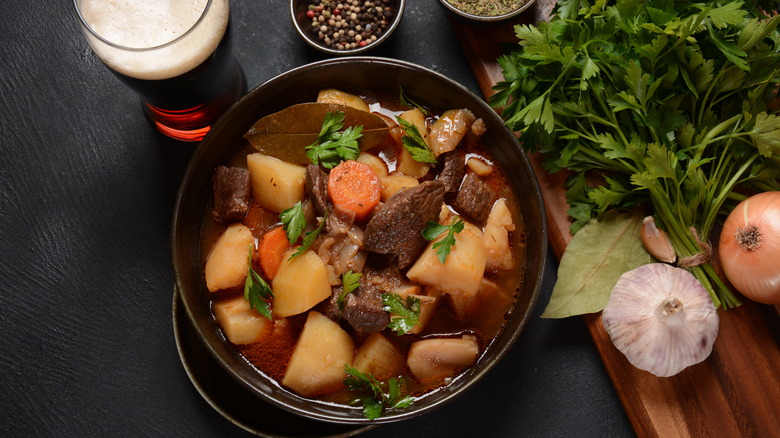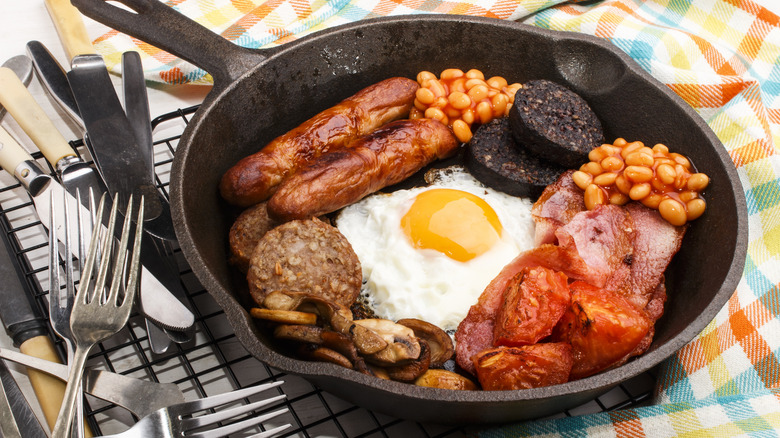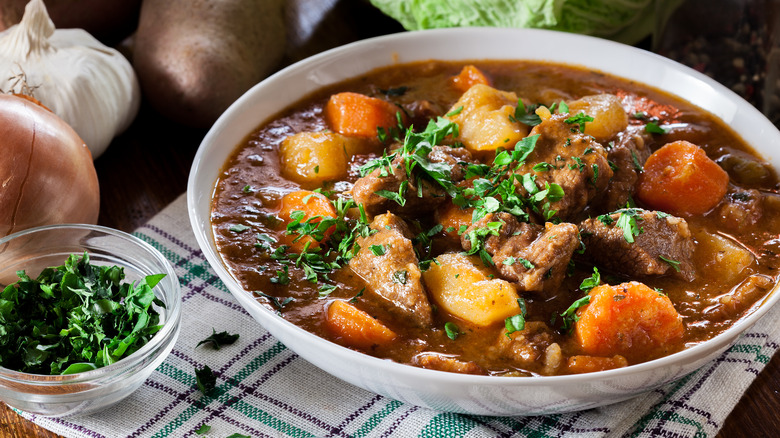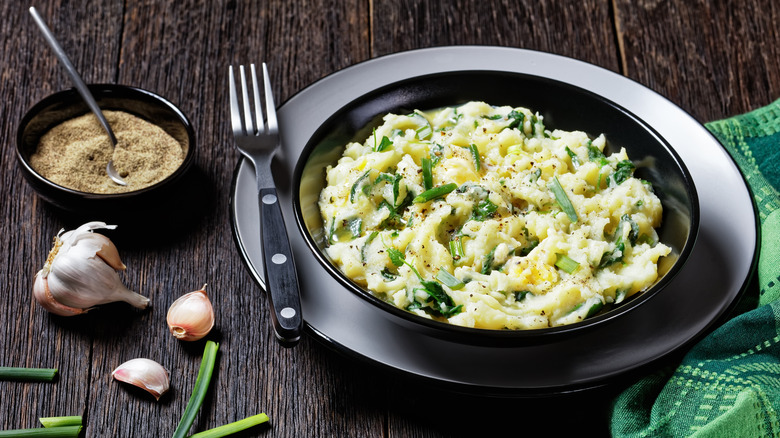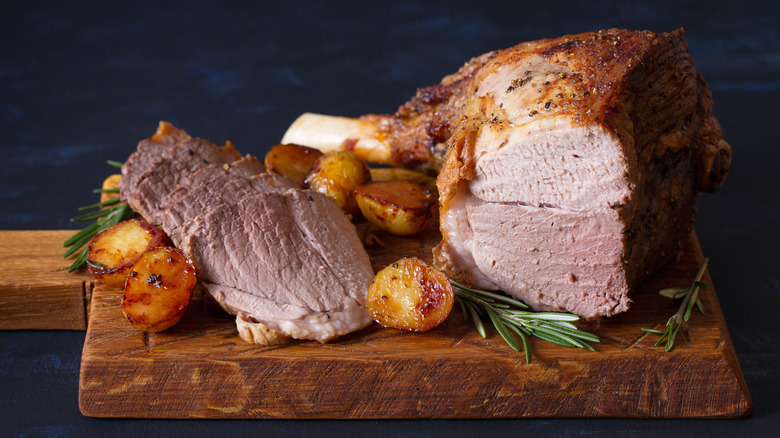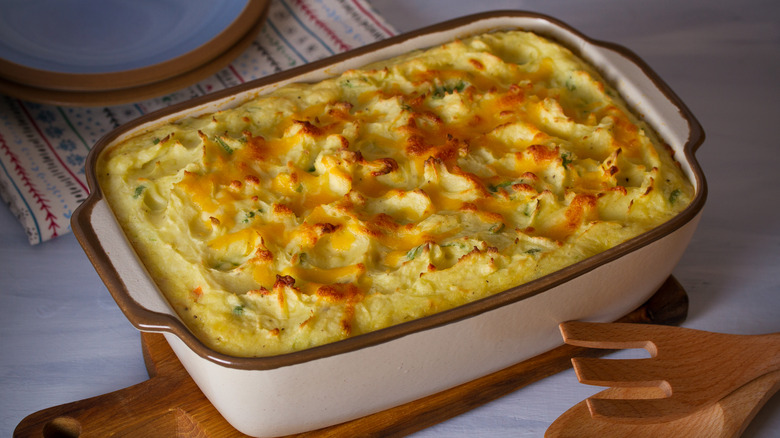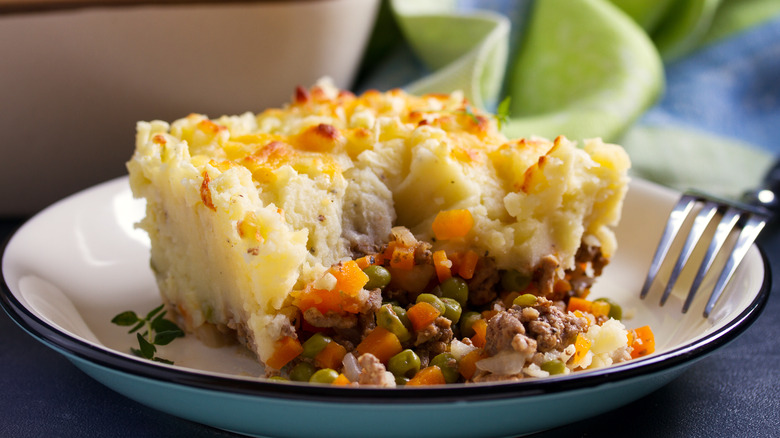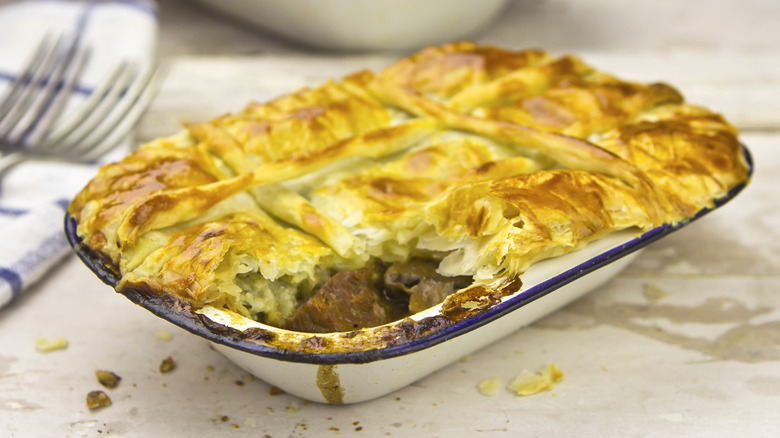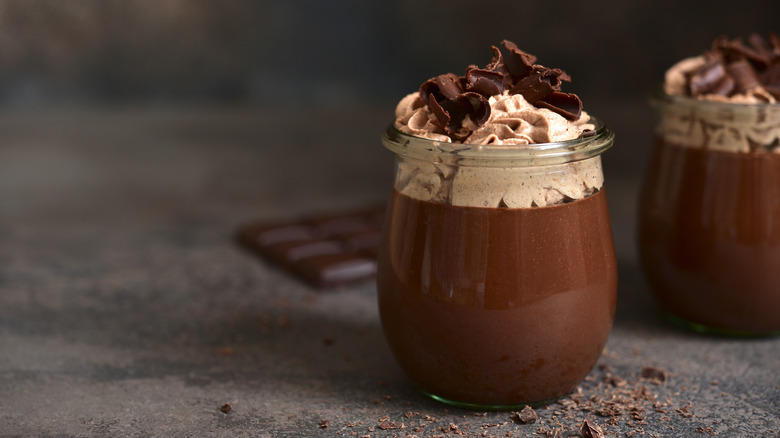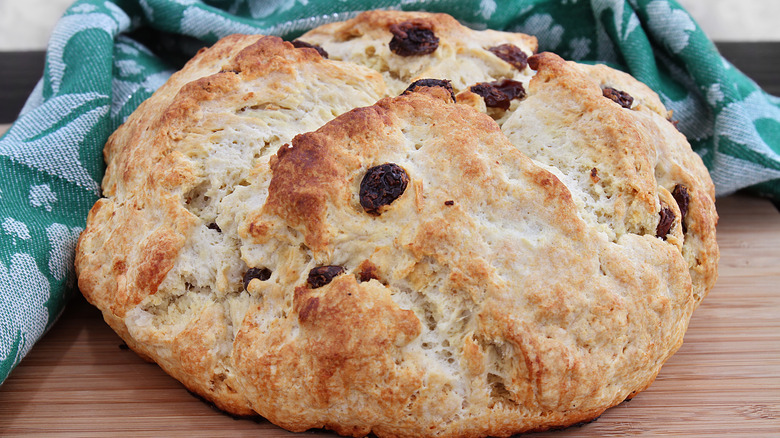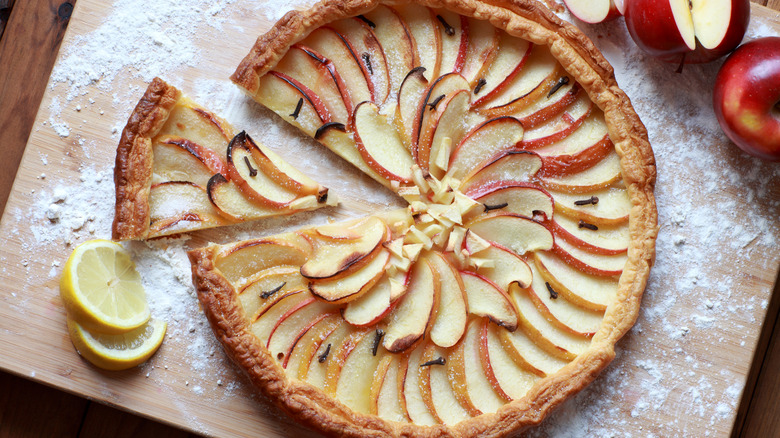St Patrick's Day: What They Eat In Ireland
In the U.S., St. Patrick's Day wouldn't be the same without corned beef and hash. For added flair, you could drink green beer, nibble on Irish soda bread, or have a green bagel. But natives of Ireland would balk at those dishes because they don't eat those foods on St. Patty's Day — that's only what Americans eat to celebrate.
While Americans dye foods green and think it's a celebration of Irish culture, it's actually a representation of a dark time in the country. Historian and native of Ireland, Christine Kinealy tells NPR it's a reminder of when people in Ireland were so hungry, they ate grass, explaining, "Before I came to America, I'd never seen a green bagel. For Irish-Americans, they think of dyeing food green, they think everything is happy. But really, in terms of the famine, this is very sad imagery."
The Irish don't have a history of eating corned beef to celebrate their patron saint either. That's because the meat was too expensive and the Irish wanted to keep the cows for milk, rather than meat. However, Irish immigrants started liking corn beef when they arrived in America, where they were introduced to the dish by Jewish Americans in New York. Read on to learn more about what people in Ireland actually eat on St. Patrick's Day.
The Irish Fry
We hope you're hungry because the Irish fry is a hearty breakfast. The name comes from the concept of putting everything in the pan and frying it up, with Irish butter of course. According to Discovering Ireland, the traditional full Irish breakfast is meant to fill you up. It started as a way to give farmworkers and other laborers a good start to a long day. But nowadays locals and tourists can enjoy the big meal even without putting in a day at work. In Ireland, it's typically enjoyed as a Sunday morning meal.
So, what's in a fry-up? This dish is a savory combination of fried eggs, earthy mushrooms, baked beans, and traditional Irish meat. Some families choose to use their favorite local sausages while others rely on quality cuts of bacon. Either way, you can't forget the potatoes to round out the one-skillet dish. This breakfast is satisfying served with a hot cup of tea and traditional homemade Irish bread with creamy butter.
Irish Stew
Considered one of Ireland's national dishes, Irish stew is so beloved that there's even an old ballad that goes, "Hurrah for an Irish stew/That will stick to your belly like glue." The filling meal is thought to have originated in the 1800s as the food of commoners, who cooked up large batches of the stew using inexpensive ingredients. They slow-cooked the stew in large pots over an open flame, and the tasty dish was simple but it fed a lot of people, (via The Emerald Isle).
Still, there's debate about what actually goes in an Irish stew. Traditionally the dish featured neck mutton chops, potatoes, onions, and water. But naturally, like any recipe, it's evolved over time. And now it's commonplace to add carrots, turnips, and even barley, to the dish (via NewsTalk). Some modern cooks even substitute beef for lamb and add extra flavors like Guinness beer.
Colcannon
Ireland and potatoes are a well-known combination. So, it makes sense that one of the most popular side dishes in Ireland is colcannon, which is made of mashed potatoes mixed with kale or cabbage. This dish is green on its own — no need for green food coloring — thanks to the creamy kale or cabbage. Be sure to add a pat of butter for extra yum.
Like a lot of Irish foods, this dish was created to be hearty and satisfying for workers who had a long day ahead. It's a simple side to make but it's adored for that simplicity too. Colcannon is a well-liked dish throughout the year including St. Patrick's Day but it's also a popular dish for Halloween. That's when the person making food mixes in symbols to represent what's ahead for those who eat the dish. A coin in your colcannon, for example, means you have fortune coming your way (via Smithsonian). And if you need a celebrity endorsement to try it, British chef Nigella Lawson says colcannon is her second favorite comfort food, right behind steamed syrup sponge and custard (via Twitter).
Spring lamb
Americans may only know lamb as an Easter delicacy. But in Ireland, lamb is very popular throughout the year. That may be because it's such an agricultural community. A survey by Board Bia, the Irish Food Board, showed countries that produce more lamb, eat more lamb. There's even a lamb season in Ireland, which peaks in the spring. According to the Irish Times, the taste of the meat starts out subtle in the spring and gets more potent as the season progresses.
American consumers are getting the chance to eat more Irish lamb as the country got approval in recent years to export sheep meat to the U.S. "Our research shows us that lamb consumption is growing in the U.S. and that consumers, particularly younger consumers, are open to eating more lamb and are willing to pay more for 'quality' lamb that is reared ethically and comes from a natural environment," said Tara McCarthy, CEO of Board Bia. Check out these recipes if you want to make a spring lamb for St. Patrick's Day.
Fish pie
Another famous Irish dish is the fish pie, which also goes by fisherman's pie, cod cobbler, and seafood pie. The comfort food is said to have originated in Scotland and is also popular in Britain. It's the perfect dish to eat during lent when Catholics can't eat meat, but fish is permitted (via Regal Fish Supplies, Ltd). The fish pie is layered and is a lot like a shepherd's pie which is topped with mashed potatoes.
This pie typically features a blend of seafood, combining poached white fish like haddock or cod with meaty prawns or shrimp. Hard-boiled eggs are also sometimes added, making the dish even more satisfying. Then, a creamy mixture of white cheese, milk or cream, and butter is poured over the other ingredients. The decadent sauce brings all the flavors together as it bakes, but the mashed potato or crusty scone topping really makes the meal.
Shepherd's pie
Shepherd's pie is another hearty Irish dish. It was actually created in Scottland where it was topped with a pastry-like crust (via Will Fly for Food). However, Irish cooks made their own twist on the dish and started topping it with mashed potatoes instead. They were less expensive, browned as they cooked, and created the same seal that allowed the dish's flavors to meld. This layered casserole is the perfect way to reuse everything left over from your Sunday dinner, including ground meat, potatoes, gravy, and vegetables, like peas and carrots.
As Irish Examiner notes, the traditional shepherd's pie is made with lamb but these days lentils can be used for a meatless approach. When beef or a combination of beef and lamb is used, the dish is known as cottage pie. The shepherd's pie is always topped with fluffy mashed potatoes, though some looking for a healthier take use whipped sweet potatoes instead. Before serving, you can also add a sprinkling of cheese and fresh herbs for more flavor and visual appeal.
Steak and Guinness pie
A savory pie with Guinness as an ingredient? It doesn't get more Irish than that. Featuring stew meat, veggies, and Guinness stout beer, tucked into a pie crust, this comfort food is popular in pubs across Ireland. It's similar to the British steak pie and makes for a satisfying main dish that pairs perfectly with fried potatoes (via 196 Flavors).
While you could probably use any beer in this recipe, Guinness is the Irish culinary go-to. "When you cook a Guinness, the alcohol tones down to a sweet sugar, but then you have the bitterness of the hops, so it's a sweet and sharp balance. The best of both worlds, but not too overpowering," Guinness Storehouse executive chef Justin O'Connor told ABC News. "When you're cooking with any other beer, the lingering taste just doesn't last with an ale. But Guinness gives it that body. Toward the end of cooking, I add a little bit and it just brings everything back to life." And if there's any Guinness left over, raise your glass, toast St. Patrick, and take a drink.
Guinness chocolate mousse
Chocolate mousse for dessert sounds great, but it also seems pretty basic. But when you add beer as a featured ingredient, this dessert goes from alright to amazing. Guinness chocolate mousse is on the dessert menu in Ireland and it's divine. It turns out the same beer that's great for savory meals, is also really good in desserts.
According to Nomads Unveiled, the chocolate mousse is infused with the stout, resulting in a decadent combination of chocolate and beer. The recipe includes egg yolks, egg whites, butter, sugar, and dark chocolate, as well as Guinness draught. The dark chocolate in this recipe adds to the richness. The dish is topped with a dollop of whipped cream for a creamy touch. Seasonal fruits, like red currents and blackberries, can also be used as a flavorful and vibrant garnish. The dessert is a must-try at the Guinness Storehouse in Dublin, where diners love the dish.
Irish soda bread
In Ireland, Irish soda bread is made with just four ingredients: Flour, salt, baking soda, and buttermilk. But in the U.S. the soda bread we know uses wheat flour and yeast (via The Society for the Preservation of Irish Soda Bread). The original soda bread was created out of need when Ireland was in a famine, and yeast was hard to come by. These days, it's still a staple in Irish households.
Recipes for Irish soda bread can vary widely. While many people start with the basic four ingredients, they get creative by adding in extra ingredients for flavor. Combinations of dry cranberries, golden raisins, honey, nuts, or caraway seeds can all be used to create a unique twist. Irish soda bread isn't the kind of bread that will last for long. Before it gets stale, enjoy it while it's hot, pair it with a soup or stew, or toast it up to be enjoyed with tea and jam. You can make your own Irish soda bread at home too.
Apple tarts
Americans often celebrate the 4th of July with the quintessential apple pie. In Ireland, they make a similar sweet dish — the apple tart. This delightful dessert is comforting, delicious, and refreshingly simple. The foundation is a typical pie crust, often made with just flour, butter, sugar, and eggs. Then, sliced apples and sugar fill the crust along with spices like cloves and a cinnamon stick. Then, it's all baked to golden brown perfection.
There are some tricks to making an apple tart like an expert Irish baker. Chilling the bottom layer of the pie plate, before putting the apples in, helps prevent a soggy pie bottom. Plus, the baker typically cuts a hole or two on the top crust. That vents the tart, which helps ensure it's cooked well inside and out (via Irish Examiner). The treat is typically served warm with a scoop of vanilla ice cream, which is something Irish and Americans can both agree with (via Nomad Unveiled).
